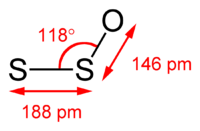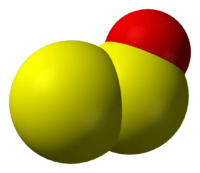Disulfur monoxide
 | |
 | |
| Names | |
|---|---|
| Other names
sulfur suboxide; Sulfuroxide; | |
| Identifiers | |
| 20901-21-7 [1] | |
| ChemSpider | 124163 |
| Properties | |
| S2O | |
| Molar mass | 80.1294 g/mol[1] |
| Appearance | colourless gas or dark red solid[2] |
| Structure | |
| bent | |
| Hazards | |
| Main hazards | toxic |
| Related compounds | |
| Related compounds |
trisulfur SO, Ozone, SO2 |
| Except where noted otherwise, data is given for materials in their standard state (at 25 °C (77 °F), 100 kPa) | |
| Infobox references | |
Disulfur monoxide or sulfur suboxide is an inorganic compound with formula S2O. It is one of the lower sulfur oxides. It is a colourless gas and condenses to give a pale coloured solid that is unstable at room temperature.[3] It is a bent molecule with an S-S-O angle of 117.88°, S-S bond length of 188.4pm, and S-O bond length of 146.5pm.[4]
Preparation
It can be formed by many methods, including combustion of sulfur is burnt in a deficiency oxygen. It arises by oxidizing sulfur with copper oxide:[5]
- 3/4 S8 + 3 CuO → 3 CuS + S2O + SO2
Other routes include the reaction of thionyl chloride with silver sulfide:
- SOCl2 + Ag2S → 2 AgCl + S2O
It also arises via thermal decomposition of sulfur dioxide ina glow discharge.[6]
Disulfur monoxide forms a yellow solution in carbon tetrachloride.[5] The solid can be obtained at liquid nitrogen temperatures, often appearing dark colored owing to impurities. On decomposition at room temperature it forms SO2 via the formation of polysulfur oxides.[6]
Discovery
Disulfur monoxide was first produced by P. W. Schenk in 1933[3] with a glow discharge though sulfur vapour and sulfur dioxide. He discovered that the gas could survive for hours at single digit pressures of mercury in clean glass, but decomposed near 30mm Hg Schenk assigned the formula as SO and called it sulfur monoxide. In 1940 K Kondrat'eva and V Kondrat'ev proposed the formula as S2O2, disulfur dioxide. In 1956, D. J. Meschi and R. J. Myers established the formula as S2O.[7]
Natural occurrence
Desulfovibrio desulfuricans is claimed to produce S2O.[8] S2O can be found coming from volcanoes on Io. It can form from 1 to 6% when hot 100 bar S2 and SO2 gas erupts from volcanoes. It is believed that Pele on Io is surrounded by solid S2O.[9]
Reactions
A self decomposition of S2O can form trithio-ozone (S3) and SO2. Also 5,6-di-tert-butyl-2,3,7-trithiabicyclo[2.2.1]hept-5-ene 2-endo-7-endo-dioxide when heated can form S2O.[10] It reacts with diazoalkanes to form dithiirane 1-oxides.[11]
Disulfur monoxide is a ligand bound to transition metals. These are formed by oxidation peroxide oxidation of a disulfur ligands. Excessive oxygen can yield a dioxygendisulfur ligand, which can be reduced in turn with triphenylphosphine. Examples are: [Ir(dppe)2S2O]+, OsCl(NO)(PPh3)2S2O, NbCl(η-C5H5)2S2O, Mn(CO)2(η-C5Me5)S2O, Re(CO)2(η-C5Me5)S2O, Re(CO)2(η-C5H5)S2O.[12]
The molybdenum compound Mo(CO)2(S2CNEt2)2 reacts with elemental sulfur and air to form a compound Mo2(S2O)2(S2CNEt2)4.[12] Another way to form these complexes is to combine sulfonyliminooxo-λ4-sulfurane (OSNSO2.R) complexes with hydrogen sulfide.[12] Complexes formed in this way are: IrCl(CO)(PPh3)2S2O; Mn(CO)2(η-C5H5)S2O. With hydrosulfide and a base followed by oxygen, OsCl(NO)(PPh3)2S2O can be made.[12]
References
- ↑ 1.0 1.1 1.2 "Disulfur monoxide". NIST. 2008.
- ↑ B Hapke and F Graham (May 1989). "Spectral properties of condensed phases of disulfur monoxide, polysulfur oxide, and irradiated sulfur". Icarus 79 (1): 47. Bibcode:1989Icar...79...47H. doi:10.1016/0019-1035(89)90107-3.
- ↑ 3.0 3.1 R. Steudel: Sulfur-Rich Oxides SnO and SnO2" in Elemental Sulfur und Sulfur-Rich Compounds II, Steudel, R., 2003, Springer, Berlin-Heidelberg. ISBN 9783540449515
- ↑ Meschi, D.J.; Myers R.J. (1959). "The microwave spectrum, structure, and dipole moment of disulfur monoxide". Journal of Molecular Spectroscopy 3 (1–6): 405–416. Bibcode:1959JMoSp...3..405M. doi:10.1016/0022-2852(59)90036-0.
- ↑ 5.0 5.1 Satyanarayana, S. R.; A. R. Vasudeva Murthy (1964). "Reactions with Disulphur monoxide Solutions Obtained by the Reduction of Cupric Oxide by Elemental Sulphur" (PDF). Proceedings of the Indian Academy of Sciences Section A 59 (4).
- ↑ 6.0 6.1 Cotton and Wilkinson (1966). Advanced Inorganic Chemistry A Comprehensive Treatise. p. 540.
- ↑ David J. Meschi and Rollie J. Myers (30 July 1956). "Disulfur Monoxide. I. Its Identification as the Major Constituent in Schenk's "Sulfur Monoxide"". Journal of the American Chemical Society 78 (24): 6220. doi:10.1021/ja01605a002.
- ↑ Iverson, WP (26 May 1967). "Disulfur monoxide: production by Desulfovibrio". Science 156 (3778): 1112–4. Bibcode:1967Sci...156.1112I. doi:10.1126/science.156.3778.1112. PMID 6024190.
- ↑ Mikhail Yu. Zolotov and Bruce Fegley (9 March 1998). "Volcanic Origin of Disulfur Monoxide (S2O) on Io" (PDF). Icarus 133 (2): 293. Bibcode:1998Icar..133..293Z. doi:10.1006/icar.1998.5930.
- ↑ Nakayama J; Aoki, S; Takayama, J; Sakamoto, A; Sugihara, Y; Ishii, A (28 July 2004). "Reversible disulfur monoxide (S2O)-forming retro-Diels-Alder reaction. disproportionation of S2O to trithio-ozone (S3) and sulfur dioxide (SO2) and reactivities of S2O and S3". Journal of the American Chemical Societ 126 (29): 9085–93. doi:10.1021/ja047729i. PMID 15264842.
- ↑ A Ishii; Kawai, T; Tekura, K; Oshida, H; Nakayama, J (18 May 2001). "A Convenient Method for the Generation of a Disulfur Monoxide Equivalent and Its Reaction with Diazoalkanes to Yield Dithiirane 1-Oxides". Angew Chem Int Ed Engl 40 (10): 1924–1926. doi:10.1002/1521-3773(20010518)40:10<1924::AID-ANIE1924>3.0.CO;2-F. PMID 11385674.
- ↑ 12.0 12.1 12.2 12.3 F G A Stone (1994-03-07). Advances in Organometallic Chemistry, Volume 36. p. 168. ISBN 978-0-12-031136-1.
| Wikimedia Commons has media related to Disulfur monoxide. |